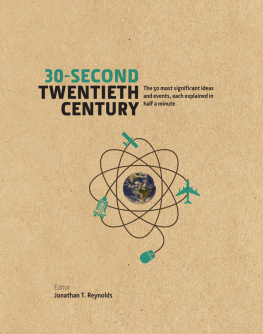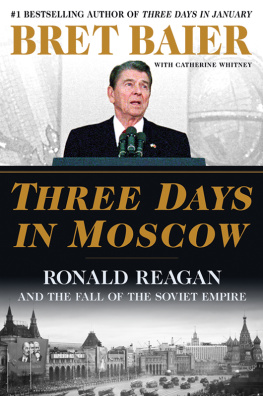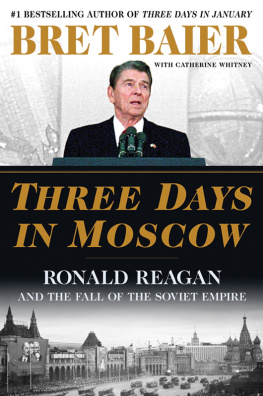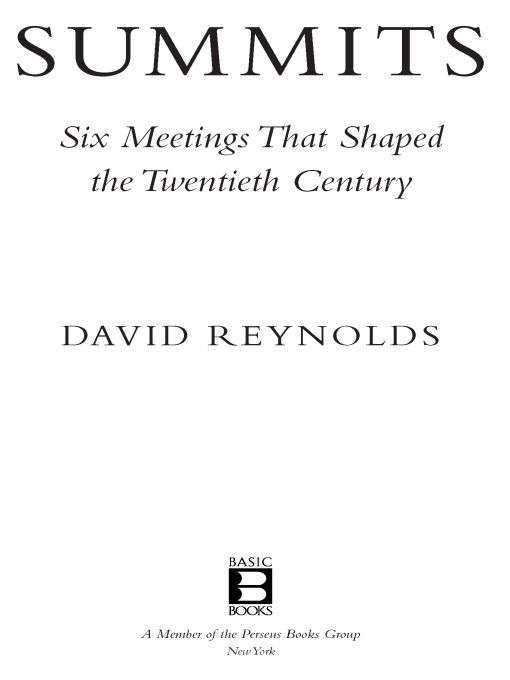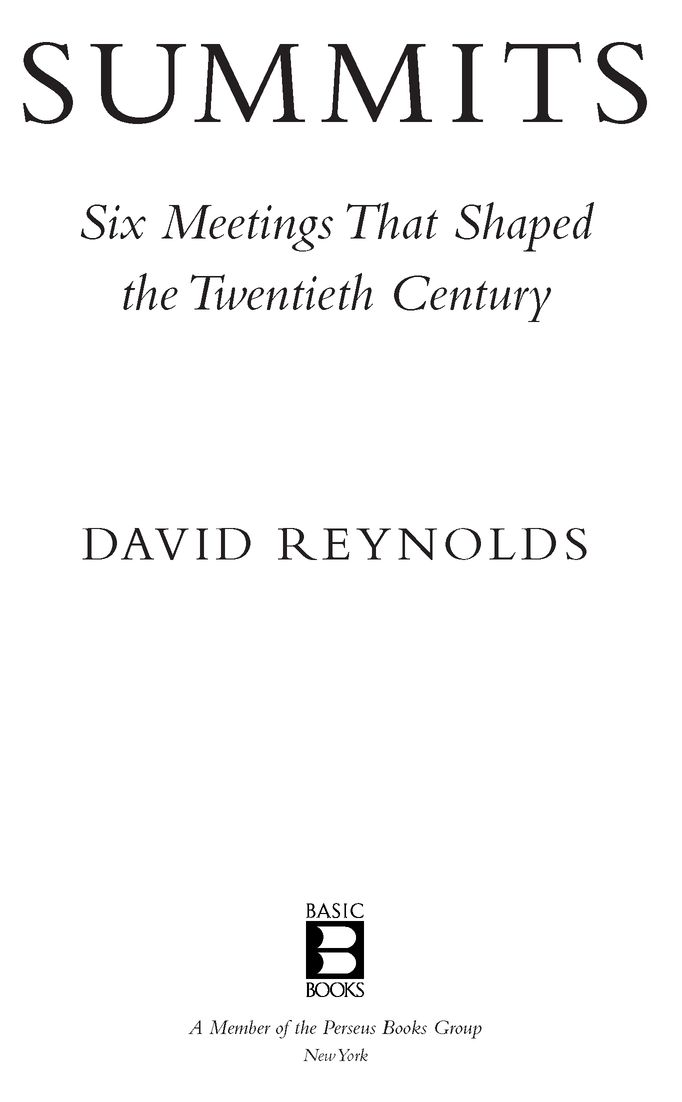Table of Contents
Table of Figures
PRAISE FOR DAVID REYNOLDSS SUMMITS
Most historians agree that summits played a central role in 20th-century international relations, but explaining how or why these meetings mattered so much has often proved frustrating.... David Reynoldsa Cambridge historianhas now filled the gap with a book that is as penetrating in its overarching analysis as it is rich in detail about individual encounters at the summit: the result is a study in international history at its very finest.Irish Times
Behind the narrative lies a muscular analytic mind.
Sunday Times
Lucid, authoritative account of big-power diplomatic parleys from Munich to Camp David.Kirkus
Reynolds had the intriguing idea of examining the conflicts of the 20th century through the lens of its pivotal summit meetings. Given his Cambridge professorship and eight books on WWII and the Cold War (Command of History), the authors thorough mastery of his subject is reflected in the fluency and assurance of the writing.
Publishers Weekly
Author David Reynolds takes us on a virtual trek to the summit and back in a book that is as entertaining and eye-opening as it is instructive.Arkansas Democrat-Gazette
This is an essential book for a deeper understanding and appreciation of the difficulties and the possibilities of international summitry.
Lincoln Journal Star
A fascinating look at historical events through this particular lens....
Library Journal
Masterly ... required reading.Spectator
David Reynolds writes with pace and verve... he has given us a fine book.Literary Review
Compellingly written ... a work of great originality ... an important book, which should change the way we think about the international history of the twentieth century.
Times Literary Supplement
ALSO BY DAVID REYNOLDS
The Creation of the Anglo-American Alliance:
A Study in Competitive Cooperation, 1937-1941
An Ocean Apart:The Relationship between Britain and America
in the Twentieth Century (with David Dimbleby)
Britannia Overruled: British Policy and World Power
in the Twentieth Century
The Origins of the Cold War in Europe (editor)
Allies at War: The Soviet, American and British Experience, 1939-1945
(co-edited with Warren F. Kimball and A.O. Chubarian)
Rich Relations:The American Occupation of Britain, 1942-1945
One World Divisible: A Global History since 1945
From Munich to Pearl Harbor: Roosevelts America and
the Origins of the Second World War
In Command of History: Churchill Fighting and Writing
the Second World War
From World War to Cold War: Churchill, Roosevelt and
the International History of the 1940s
FOR MY MOTHER
It is not easy to see how things could be worsened by a parley at the summit.
Winston Churchill, Feb. 14, 1950
It is far better that we meet at the summit than at the brink.
John F. Kennedy, Oct. 1, 1959
Its always the same with these conferences ...
The Great Men dont know what theyre talking about
and have to be educated.
Sir Alexander Cadogan,Yalta, Feb. 6, 1945
If great princes have a desire to continue friends, in my judgment they ought never to meet.
Philippe de Commines, c. 1490
INTRODUCTION
THE TERM SUMMIT was coined by Winston Churchill. Speaking in Edinburgh on February 14, 1950, in the dark days of the Cold War, he called for another talk with the Soviet Union at the highest level, adding that it was not easy to see how matters could be worsened by a parley at the summit. What prompted Churchill to apply summit to diplomacy is not clear, but the word was popping up in British newspapers because expeditions to scale Mount Everest, the worlds highest peak, had resumed in the late 1940s. Repeating his call for a conference on the highest level on May 11, 1953, Churchill appealed for a will to peace at the summit of the nations. He delivered this speech to the House of Commons while the eighth attempt on Everest was in progress: the summit was finally conquered at the end of that month.
The Everest obsession helps explain why Churchills metaphor rooted itself in popular consciousness. A conference of the American, Soviet, British and French leaders in Geneva in July 1955 was billed as a Parley at the Summit by Time magazine, and summit was picked up as an official term by the U.S. State Department. Cartoonists portrayed world leaders eyeing a peak or perched uncomfortably on its top (
Yet familiarity breeds insensitivity. It is worth reflecting for a moment on Churchills arresting phrase a parley at the summit. The archaic parley, much used by Shakespeare, evokes a hazardous encounter between enemies to broker terms. In Titus Andronicus, for instance, the scheming Empress Tamora tells the Roman noble, Aemilius:
Go thou before, be our ambassador:
Say that the emperor requests a parley
Of warlike Lucius
And summit conjures up the heritage of European Romanticismthe mountain peak as both perilous and sublimecelebrated, for example, by the poet William Wordsworth, the novelist Thomas Mann or the painter Caspar David Friedrich. The mountain is a place of danger, its conquest a moment of personal triumph and liberation. In the lines of Lord Byron:
All that expands the spirit, yet appals,
Gathers around these summits, as to show
How Earth may pierce to Heaven, yet leave vain man below.
From the top one sees the world in a new and different way, for good or ill, because a mountain is a magical place. Shelley was overwhelmed by his first visit to the Alps in 1816. The immensity of these arial summits excited, when they suddenly burst upon the sight, a sentiment of extatic wonder, not unallied to madness.
Churchills summit also echoes the sacred mountain of Judaeo-Christian traditionMoses ascending Sinai to bring back Gods law to his people, Christ tempted by visions of an earthly kingdom or transfigured in a flash of divine approval. Standing on a bare mountain, at the mercy of nature, human beings experience a moment of judgment in which they are reduced to their true size in the cosmos. J.M.W. Turners epic painting of Hannibals army crossing the Alps in a snowstorm depicts the great commander as a minuscule silhouette clinging to his elephant at the bottom of the apocalyptic skyscape. Painted in 1812, it has even been interpreted as a premonition of Napoleons downfall.
Despite the dangers, many climbers find it hard to keep away from the summits. After his first expedition to Everest in 1921, George Mallory wrote that the highest of mountains is capable of severity, a severity so awful and so fatal that the wiser sort of men do well to think and tremble on the threshold of their high endeavour. Yet Mallory did not heed his own words: he returned to Everest in 1922 and again in 1924. Asked why by a reporter, he uttered the immortal line: Because its there.




